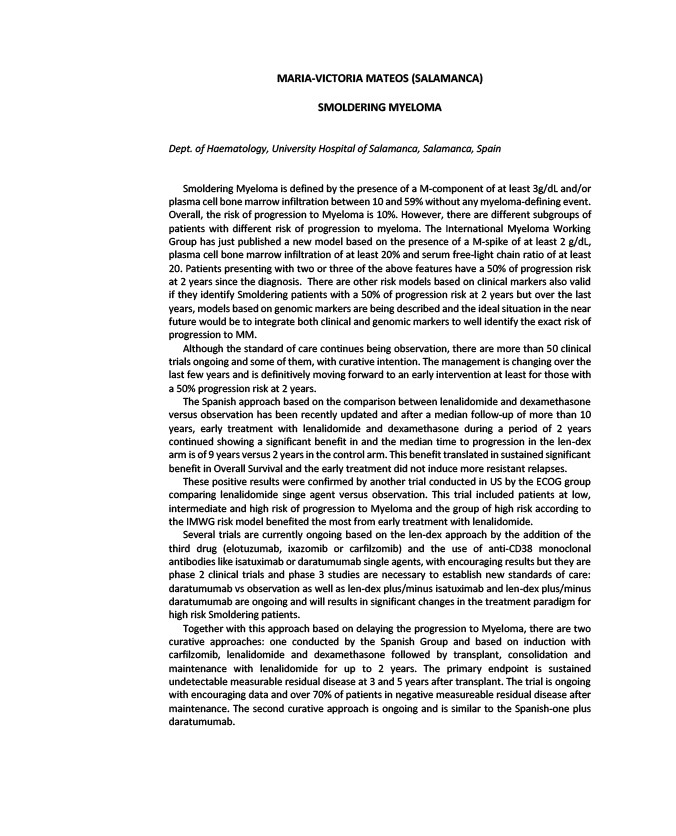
MARIA-VICTORIA MATEOS (SALAMANCA)
SMOLDERING MYELOMA
Dept. of Haematology, University Hospital of Salamanca, Salamanca, Spain
Smoldering Myeloma is defined by the presence of a M-component of at least 3g/dL and/or
plasma cell bone marrow infiltration between 10 and 59% without any myeloma-defining event.
Overall, the risk of progression to Myeloma is 10%. However, there are different subgroups of
patients with different risk of progression to myeloma. The International Myeloma Working
Group has just published a new model based on the presence of a M-spike of at least 2 g/dL,
plasma cell bone marrow infiltration of at least 20% and serum free-light chain ratio of at least
20. Patients presenting with two or three of the above features have a 50% of progression risk
at 2 years since the diagnosis. There are other risk models based on clinical markers also valid
if they identify Smoldering patients with a 50% of progression risk at 2 years but over the last
years, models based on genomic markers are being described and the ideal situation in the near
future would be to integrate both clinical and genomic markers to well identify the exact risk of
progression to MM.
Although the standard of care continues being observation, there are more than 50 clinical
trials ongoing and some of them, with curative intention. The management is changing over the
last few years and is definitively moving forward to an early intervention at least for those with
a 50% progression risk at 2 years.
The Spanish approach based on the comparison between lenalidomide and dexamethasone
versus observation has been recently updated and after a median follow-up of more than 10
years, early treatment with lenalidomide and dexamethasone during a period of 2 years
continued showing a significant benefit in and the median time to progression in the len-dex
arm is of 9 years versus 2 years in the control arm. This benefit translated in sustained significant
benefit in Overall Survival and the early treatment did not induce more resistant relapses.
These positive results were confirmed by another trial conducted in US by the ECOG group
comparing lenalidomide singe agent versus observation. This trial included patients at low,
intermediate and high risk of progression to Myeloma and the group of high risk according to
the IMWG risk model benefited the most from early treatment with lenalidomide.
Several trials are currently ongoing based on the len-dex approach by the addition of the
third drug (elotuzumab, ixazomib or carfilzomib) and the use of anti-CD38 monoclonal
antibodies like isatuximab or daratumumab single agents, with encouraging results but they are
phase 2 clinical trials and phase 3 studies are necessary to establish new standards of care:
daratumumab vs observation as well as len-dex plus/minus isatuximab and len-dex plus/minus
daratumumab are ongoing and will results in significant changes in the treatment paradigm for
high risk Smoldering patients.
Together with this approach based on delaying the progression to Myeloma, there are two
curative approaches: one conducted by the Spanish Group and based on induction with
carfilzomib, lenalidomide and dexamethasone followed by transplant, consolidation and
maintenance with lenalidomide for up to 2 years. The primary endpoint is sustained
undetectable measurable residual disease at 3 and 5 years after transplant. The trial is ongoing
with encouraging data and over 70% of patients in negative measureable residual disease after
maintenance. The second curative approach is ongoing and is similar to the Spanish-one plus
daratumumab.